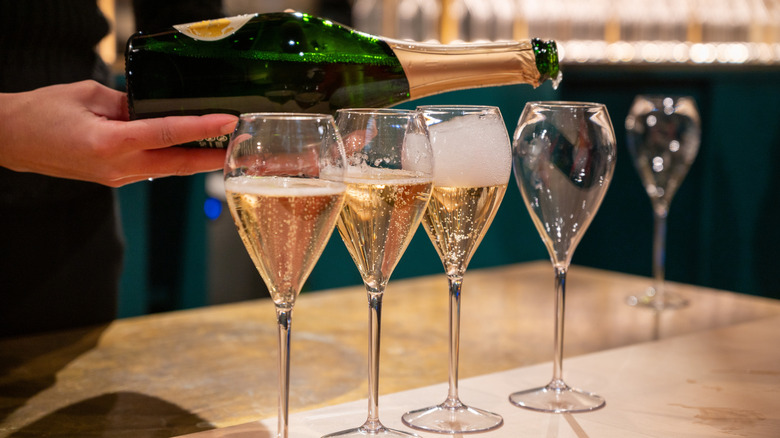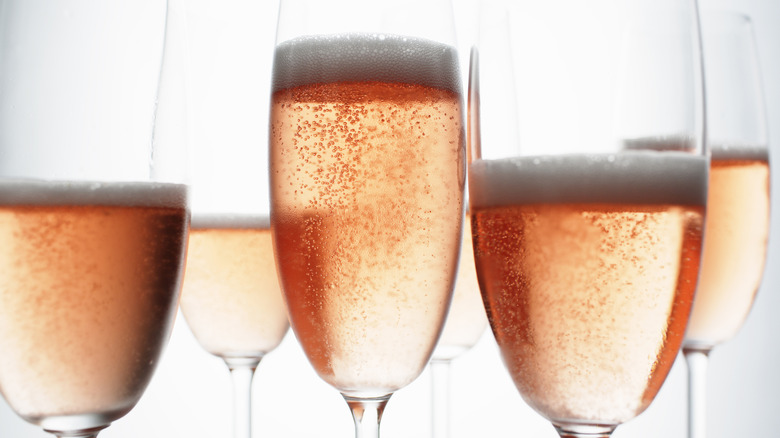What Makes Spumante Wine Different From Champagne?
Champagne has long been associated with luxury, and is the drink of choice for toasting milestones like birthdays, promotions, and everything in between. Its effervescent bubbles and distinct, fruity flavor set it apart from other sparkling wines. However, Champagne is not always the easiest thing to find. Authentic Champagne is produced only in the Champagne region of France, and intricate production rules, including specific grape varieties and the time it takes to properly age a bottle, limit its availability. Moreover, its global high demand has greatly driven up prices and made it even more challenging for the average person to get their hands on a genuine bottle — a reality that has become even more serious in the wake of the COVID-19 pandemic.
These classy bottles haven't completely disappeared, though. You can even buy Champagne at Costco, in fact. But the effort it can take to find some good bubbly has led people to explore other, more accessible sparkling wine options, such as those in the spumante category. But what exactly separates these two drinks? We're here to explore the complex answer to that question.
What is Champagne?
What makes champagne unique (and pricey) is its complex production process, known as the "méthode champenoise." This meticulous process requires a second fermentation inside the bottle, which is how the beverage develops its signature tiny bubbles (If you want your Champagne to stay bubbly after opening, check out this tip). Only grapes grown in the Champagne region, typically Chardonnay, Pinot Noir, and Meunier grapes, can be turned into Champagne . Even the terrain of the region contributes to making this unparalleled wine, as the rocky, chalky soil provides minerals to the vine.
At some point in the fermenting process, a bit of sugar will be added to the Champagne. Depending on how much sugar is added, Champagne will sit somewhere on the sweetness spectrum between "Brut nature" (no added sugar) and "Doux" (over 50 grams of sugar per liter). Afterward, a bottle of Champagne must age for at least 15 months, or even more if the grapes come from a single harvest. Champagne can taste different if it's made with certain amounts of sugar or various combinations of grapes, but it typically has a bright, fruity taste with a hint of bread or nuts.
What is spumante wine?
Spumante is Italy's response to exclusive French sparkling wine. The word "spumante" translates to "foaming" in Italian, and the term can apply to wines made with any grapes or in any Italian region, including everything from sparkling red wine to sparkling rosé. One of the most popular styles of spumante is Asti Spumante, a sweeter wine made primarily from the Moscato grape. The term spumante may also be used interchangeably with prosecco, but this is not entirely correct. Prosecco is a type of sparkling wine, so it falls under the "spumante" category, but a beverage that is spumante is not automatically prosecco.
Although it can be made using the Champagne method, spumante is often made using the Charmat method, also known as the tank method. This technique uses two rounds of fermentation like the méthode champenoise, but the second round takes place in a large vat instead of individual bottles. The Charmat method cuts down the cost of the final product since everything is made en masse, but it still produces delicious, fresh-tasting wine like the many forms of spumante.
Sparkling similarities
Since spumante is a category of sparkling wine, and Champagne is a specific sparkling wine, they do share some similarities. Both are made using double fermentation, and both share a fizzy texture with a fresh taste that can range from dry to sweet. Just as Champagne is often classified into categories like Brut, Extra Brut, and Demi-Sec depending on the sugar content, spumante can range from dry styles like Spumante Brut to sweet varieties like Asti.
While usually reserved for special occasions, both Champagne and spumante wines are also commonly served at brunch, as an aperitif, or paired with dessert. Regardless of the time of day, the two wines are ideally served cold to really capture the carbonated sensation. Spumante wines, like prosecco and Champagne, pair well with foods like fruit, cheese, seafood, or pastries. Finally, Champagne and spumante wines are often poured into flute glasses, but there's actually a different type of glassware you should be using.
More differences between Champagne and spumante
Thanks to the Charmat method, many types of spumante are available at a more affordable price point than Champagne. This affordability makes spumante a go-to option for casual celebrations, while Champagne's exclusiveness makes it more suited for grand events.
In terms of taste, Champagne tends to offer more complexity, with flavors that develop through long aging and careful blending of grape varieties. Champagne often features a yeasty, toasty character that comes from extended contact with the yeast during aging. Spumante, by contrast, tends to have more pronounced fruity and floral notes, especially in sweeter versions like Asti Spumante. The two wines can serve similar purposes, but the depth and elegance of Champagne generally stands out more in formal or high-end occasions.
Ultimately, while both spumante and Champagne offer effervescent enjoyment, they cater to different occasions, tastes, and budgets. If you're looking for an iconic, prestige drink, Champagne is the classic choice; but for something light, sweet, and easily accessible, spumante provides an excellent alternative.




